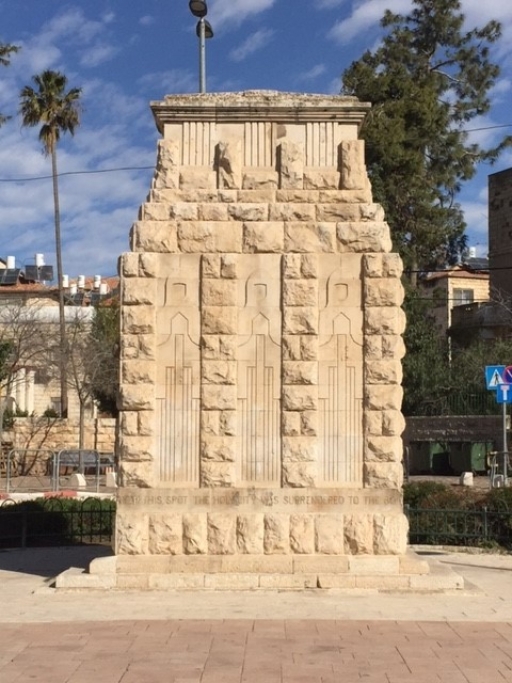A First Wold War conference has been held in Jerusalem, Israel. Jillian Davidson attended the conference, and has sent in this personal account of the event.
Convened on February 26, 2015 at Efrata College of Education in Jerusalem, the conference “A World in Turmoil: World War I and its Impact on the Jewish World” was the brainchild of Professor Michal Ben Ya’akov.
In recent years, the study of Palestine in World War One has moved beyond politics and the military, and towards the societal experiences of civilians in war. Many of the papers in the morning at Efrata contributed to this new perspective. They examined the way the settlers in Palestine lived through and recorded the war, questioned whether there was a difference between how men and women experienced it, and reflected whether the war was positive, empowering to women, or negative and weakening to women.
Though some historians hold that Jews were better off than other populations in Palestine, Dr. Ben Yaakov maintained that the opposite was in fact the case. She argued that Jews were more dependent on outside help, which was cut, and this especially affected single Jewish women. In the 19th Century, approximately two thirds of all adult Jews in the Land of Israel were women. An overwhelming number of these women were widows. Moroccan widows in Jerusalem often lived together during the war in one room to help each other.
Jews were urban, and not agrarian, and so lacked the wherewithal to produce food. Any attempts to create more places for work were for men. Embroidery shops were closed since there was no longer a market. Many women organized bringing food to those too weak to go themselves to the soup kitchens.
In the afternoon of the conference, papers turned their attention to Eastern European Jewry and the war in rabbinical rulings. Talking about Lithuanian Jewry, Dr. Ben-Tsiyon Klibansky explained the impact of the Russian expulsions of Jews. Accused of spying for Germany, the exiled Jews of Brisk and Kovno did not know where they were going and mostly went by foot. Many refugees were doubly uprooted. They lost their Jewish connection to ritual and learning along with their homes.
I came to Efrata to present the concluding paper on the state of WWI Jewish education: “What is the Jewish Community doing for the First World War Centenary? Jewish Perspectives on WWI education and remembrance.” Based on a Jewish Centenary Survey, which I conducted in the classrooms of six Jewish High Schools in New York, New Jersey and London between May, 2013 and May, 2014, I explored the difference between students’ understanding of the First World War in general and their appreciation of the Jewish war experience in particular.
Significantly, the further into the survey all the students went, as the questions turned from general ones to those relating to the Jewish experience, the weaker their knowledge became. Considering the calendar of Jewish Centenary events happening in Europe and America (musical or literary recitals, new books, articles and blogs, lectures, conferences and exhibitions), there seems to be a lack of conversation between Jewish centenary commemorators, academics, Jewish educators and students.
In Jerusalem, however, commemorators, academics, educators and students appear to be more in sync with each other. Dr. Michal Ben Ya’akov herself had previously created a certification program for Teaching the Holocaust and its Commemoration, which she has headed since 2007. At the conference, she was applying the principles and practice of her Holocaust program to learning about the First World War and commemorating it, not only in the academic conference, but also in a course for college students. Into the conference hall, Dr. Ben Ya’akov had brought a class of young students, who were attending as part of a larger credit course on WWI.
The second day of the conference moved beyond the lecture hall to the neighborhoods, streets and sites of Jerusalem as we embarked upon a WWI walking tour. Our guide was Eran Tearosh, a professional Israeli tour guide and the chairman of The Society for the Heritage of World War One in Israel. Mr. Tearosh led us from Romema to inside the Jaffa Gate, tracing the footsteps of the British Army as they entered Jerusalem, December 9th 1917.
Just off the Tel Aviv-Jerusalem highway at the main entrance to the city, upon Jerusalem’s highest hill, Romema is home to a prominent war memorial erected in 1920. Encircling the memorial are silhouettes of Crusader knights who, like the British, conquered Jerusalem. The inscription around the base reads: “Near this spot, the Holy City was surrendered to the 60th London Division, 9th December 1917.”
Never was the presence of history felt so acutely as when we walked through the Jaffa Gate and to the Tower of David, where Allenby had proclaimed Britain’s occupation of Jerusalem. This proclamation, which was issued in 7 languages, announced Britain’s occupation but also promised respect to the city’s three religions. Our guide read it dramatically to us in Hebrew.
As a special treat after the tour, still inside the Jaffa Gate, we visited Jerusalem’s Christ Church Heritage Centre to see a small but most fitting exhibit to conclude the conference: “Faith and Fortitude. The Life and Times of Lt. Gen. Sir William Dobbie.” Dobbie was the British officer who signed the telegram that ended World War I.
The conference at Efrata College is just one of many centenary conferences that have already convened in Jerusalem. It is also anticipated that these activities, on a more popular and educational level, will increase considerably in the second half of 2017 to the fall of 2018, one hundred years after the fighting came to Palestine and the British gained control.
